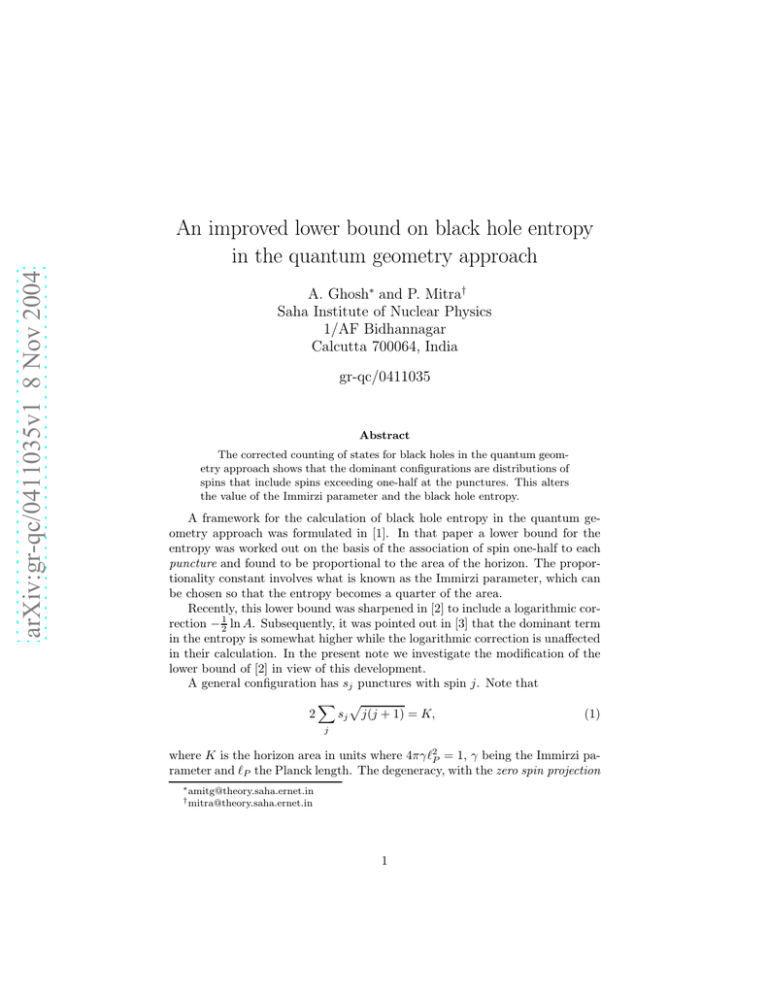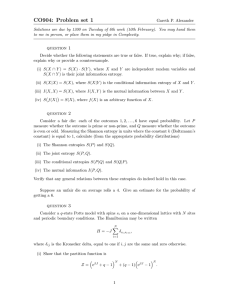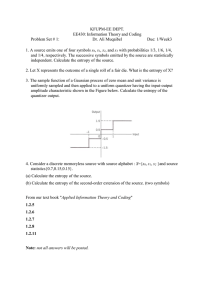An improved lower bound on black hole entropy in the quantum
advertisement

arXiv:gr-qc/0411035v1 8 Nov 2004 An improved lower bound on black hole entropy in the quantum geometry approach A. Ghosh∗ and P. Mitra† Saha Institute of Nuclear Physics 1/AF Bidhannagar Calcutta 700064, India gr-qc/0411035 Abstract The corrected counting of states for black holes in the quantum geometry approach shows that the dominant configurations are distributions of spins that include spins exceeding one-half at the punctures. This alters the value of the Immirzi parameter and the black hole entropy. A framework for the calculation of black hole entropy in the quantum geometry approach was formulated in [1]. In that paper a lower bound for the entropy was worked out on the basis of the association of spin one-half to each puncture and found to be proportional to the area of the horizon. The proportionality constant involves what is known as the Immirzi parameter, which can be chosen so that the entropy becomes a quarter of the area. Recently, this lower bound was sharpened in [2] to include a logarithmic correction − 21 ln A. Subsequently, it was pointed out in [3] that the dominant term in the entropy is somewhat higher while the logarithmic correction is unaffected in their calculation. In the present note we investigate the modification of the lower bound of [2] in view of this development. A general configuration has sj punctures with spin j. Note that X p (1) sj j(j + 1) = K, 2 j where K is the horizon area in units where 4πγℓ2P = 1, γ being the Immirzi parameter and ℓP the Planck length. The degeneracy, with the zero spin projection ∗ amitg@theory.saha.ernet.in † mitra@theory.saha.ernet.in 1 constraint ignored, is P ( j sj )! Y (2j + 1)sj . N= Q j sj ! j (2) The actual degeneracy is of course lower because of the constraint. One has to sum over N with all nonnegative sj consistent with the given value of K. We can bound the sum by maximizing the above expression with respect to the variables sj subject to a fixed value of K. Using Stirling’s formula, we see that X X X sj ). (3) sj ) ln( sj [ln(2j + 1) − ln sj ] + ( ln N = j j j Hence, δ ln N = X j δsj [ln(2j + 1) − ln sj + ln X sk ], (4) k so that with some Lagrange multiplier λ to implement the area constraint, we can set X p ln(2j + 1) − ln sj + ln sk − λ j(j + 1) = 0. (5) k Thus, X p sk . sj = (2j + 1) exp[−λ j(j + 1)] (6) k Summing over j, we obtain the relation X p (2j + 1) exp[−λ j(j + 1)] = 1, (7) j which determines λ ≃ 1.72. Substituting the expression for sj one easily gets the entropy to be ln N = λK/2. (8) Note that the consideration of other configurations could raise this value, while the imposition of the zero projection constraint is expected to lower it slightly. The higher spins clearly alter the leading term, but our expression is larger than that of [3]. The difference arises from the fact that we have allowed m = −j, ...j for each j, whereas [3] has m = ±j. Thus they have X p (9) 2 exp[−γ̃ j(j + 1)] = 1 j 2 instead of (7). However, if one allows m all its values, their first recursion relation (with the zero projection constraint ignored) is altered to p X p (2j + 1)N (K − 2 j(j + 1)) + K 2 + 1, N (K) = (10) j which is satisfied by our estimate N (K) = exp(λK/2) (11) with λ satisfying (7) above. Our expression for the entropy agrees with the solution obtained from the corrected recursion relation with the zero projection constraint ignored. If one imposes the constraint of zero angular momentum projection, the number of configurations will be reduced somewhat, and a correction is expected to emerge. We shall find a lower bound by taking the sj spins j to be distributed equally over the values −j, −j + 1, ...j for each j. This maximizes the number of combinations Y sj ! (12) sj,−j !sj,−j+1 !...sj,j ! j and also ensures zero total spin projection for each j, hence for the sum. The denominator leads to ap correction −(j + 1/2) ln[sj /(2j + 1)]. (Cf. [2].) As sj /(2j + 1) ∝ K exp[−λ j(j + 1)], this yields a correction X p (13) [ln K − λ j(j + 1)](j + 1/2), − j which appears to be divergent. This happens because all sj have been assumed to be large, although for large j, sj in the expression given above goes to zero. So we restrict the sum to j for which sj is greater than unity. Taking the largest j to be n/2, we see that p exp −[λ n(n + 2)/4]K ≃ 1, (14) so that n ≃ 2 ln K/λ. (15) Now X j j = n(n + 1)/4 ≃ (ln K)2 /λ2 . (16) p Therefore the ln K piece yields a (ln K)3 correction. The piece −λ j(j + 1) also has to be taken into account, using the sum X j 2 ≃ n3 /12 ≃ 2(ln K)3 /(3λ3 ). (17) j 3 The total correction comes to −(ln K)3 /(3λ2 ): the total entropy is bounded by the contribution of these configurations: S ≥ ln Ncorr = λK/2 − (ln K)3 /(3λ2 ). (18) This is our new lower bound. It must be pointed out that this has been derived by assuming a specific distribution of spins and spin projections to give the largest number of combinations. A sum over different distributions can in principle raise the entropy. One cannot rule out the possibility of the -(ln K)3 terms going away as a result of such summation. Note that there also are additional nonleading corrections to the expressions used above for the combinatorial factors, and contributions from e.g., the 1/2 in (j + 1/2) have been neglected, but these are much smaller in magnitude than (ln K)3 and yield (ln K)2 and ln K pieces. The question is whether the (ln K)3 or (ln K)2 terms survive. Such corrections have not been seen in any earlier work. In particular, let us now go through the arguments of [3] with the corrected range of m P to estimate the correction. An approximation to the number of states with m = 0 is Z N (K, 0) ≃ dω exp(s(ω)K/2), (19) where s(ω) satisfies 1= X e−s(ω) √ j(j+1) j X eiωm . (20) m=−j j This equation differs from that of [3] in m going over −j, ..., j, whereas their m goes over ±j. For ω = 0, this resembles (7), so s(0) = λ. This yields the dominant contribution exp(λK/2) seen above. If it is assumed that ω is small, so that s(ω) changes quadratically, the ω integral becomes a gaussian, which is readily seen to be proportional to K −1/2 by appropriate scaling. This produces a correction − 21 ln K to the entropy as in [2, 3]. This seems to suggest that the (ln K)3 , (ln K)2 terms do not survive when summed over configurations. References [1] A. Ashtekar, J. Baez and K. Krasnov, Adv. Theor. Math. Phys. 4, 1 (2000) [gr-qc/0005126] [2] A. Ghosh and P. Mitra, gr-qc/0401070 [3] M. Domagala and J. Lewandowski, gr-qc/0407051; K. A. Meissner, grqc/0407052 4






